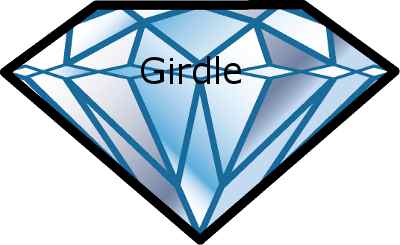Quick and Easy Buying Guide
Carat weight: 1 carat = 200 milligrams = 6.5 mm diameter. Doubling weight doesn't double diameter.
Diamond clarity: FL/IF/VVS/VS = super expensive, near perfect. SI = best value if you can check a photo for obvious inclusions (defects).
Color: D-G = colorless, expensive, only if you have money to burn. H-J = best value. Can go lower in gold metal settings than white metal.
Cut: Better cut ratings let more light into a diamond, making it sparkle more. Very important property, don't skimp here.
Set a budget and minimum cut (Premium). Go J color for gold and I/H for white metals. Go searching for SI1/SI2 clarity diamonds at James Allen. Pick a diamond with small/no inclusions. Choose a ring setting and buy it risk-free (60-day returns).
Diamond Girdle Thickness
One of the often overlooked properties of a diamond is the diamond girdle thickness. This is the thickness of the outer edge of the diamond when viewed from the side (see the diagram below). The girdle thickness can have a critical effect on both the value and appearance of the diamond.
Sponsored Links

First up – the surface of the girdle usually takes one of three forms. A faceted girdle has been specially created by the jeweler. A bruted diamond is one which has been ground against another diamond on a lathe in order to give a smooth, polished appearance. The third option is the “natural” standard granular surface.
The GIA rating of a diamond only depends on the girdle thickness, not the appearance of the girdle surface. So consider the surface of the diamond from an appearance point of view, but know that it won’t affect the official rating.
The girdle thickness is its most important characteristic. The thickness range varies from thinnest to thickest with the following descriptions:
Extremely Thin
Very Thin
Thin
Medium
Slightly Thick
Thick
Very Thick
Extremely Thick
The ideal girdle thickness is between “Very Thin” and “Thick”. If you’re wanting to go for a high end diamond, then you might make this range even more fussy, and pick a diamond with a girdle thickness between “Thin and Slightly Thick”. Note that girdle thickness can also be defined as a percentage of the diamond diameter, so don’t be surprised if you see some girdle thicknesses defined as a percentage. The bigger the percentage, the thicker the girdle.
The caveat to this ideal diamond thickness specification is that a typical diamond will have a variable girdle thickness. For example, a diamond may have a medium girdle around most of the edge (an ideal diamond girdle), but then have a very small “Very Thick” girdle section.
This diamond probably wouldn’t get a “Medium” rating even though most of the girdle was “Medium” in thickness. In this case, you could either inspect the diamond in person or (if you’re buying online) ask a staff member to examine the girdle and report back to you. You might be able to get a bargain this way.
One of the most critical indirect effects of girdle thickness is on the apparent size, or spread of the diamond. A diamond with a very thick or extremely thick girdle will have a lot of the mass of the diamond in the widest part of the diamond. The problem with that is that the diamond will not generally be as “wide” as a diamond with the same carat rating, but a less thick girdle.
If you’re looking to get the biggest diamond possible, you might logically then think that you should be searching for a diamond with a very thin girdle. However, there are many problems with having a thin girdle as well. One of them is the potential for damaging the diamond. A very thin section of girdle, if impacted, can easily break and critically damage the diamond. When a jeweler sets a diamond with a girdle that is very thin in sections, they may try to have those sections somewhat protected in the setting, leaving the thicker parts of the girdle to be exposed.
Lastly, you should be aware that the different diamond certification systems measure the girdle thickness in different ways – some laboratories in Europe measure differently to some laboratories in the United States. For example, AGS laboratories measures the girdle thickness at the thickest part of the girdle. If you’ve taken the time to pay attention to girdle thickness, it’s worth your while also asking and researching how the girdle thickness was measured for the particular diamond you are looking at.

